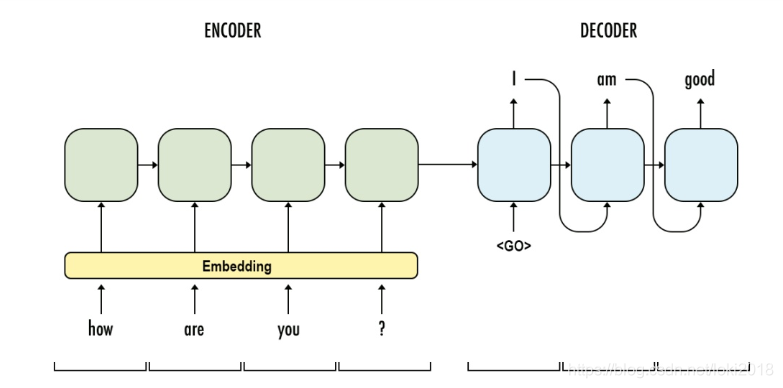-
结构
这是一种经典的Seq2Seq结构,由两部分组成,Encoder 和 Decoder(编码器和解码器), 这两个部分的构造几乎一模一样,都是由循环神经网络组成,层数,隐藏层维度都是一样的。
它的原理是一个序列输入到编码器之后,编码器输出最后的隐藏状态(h)到解码器, h包含了序列的前后信息,然后通过解码器对h处理,逐步生成相应的预测序列。

-
Encoder
以下是Encoder的一段基本代码,由最基本的RNN组成:
需要弄清楚它矩阵的变换。
class EncoderRNN(nn.Module):
def __init__(self,input_size, hidden_size, n_layers, emb_size, dropout=0.5, bidirections=False):
"""
:param input_size:源序列的编码总数, 例如英文26个字母,那么这里就是26
:param hidden_size:隐藏层参数
:param n_layers: 网络层数
:param emb_size: embedding维度
:param dropout: dropout参数
:param bidierctions: 双向还是单向
"""
super(EncoderRNN, self).__init__()
self.input_size = input_size
self.n_layers = n_layers
self.hidden_size = hidden_size
self.emb_size = emb_size
self.dropout = dropout
self.bidirecions = bidirections
self.Embedding = nn.Embedding(self.input_size, self.emb_size) # embedding编码
self.RNN = nn.RNN(self.emb_size, self.hidden_size, self.n_layers, dropout=self.dropout, bidirectional=self.bidirecions)
def forward(self, src):
# src [seq_len, batch]
embedded = self.Embedding(src)
#embedded [seq_len, batch, emb_size]
out, h = self.RNN(embedded)
# out [seq_len, batch, direction*hidden_size]
# h [n_layers*directions, batch, hidden_size]
return out, h
然后我们任意设定一个序列输入到网络中,pytorch中的循环神经网络喂入的数据形式比较特殊,它的batch_size并不是在第一维,而是在第二维,因此我们的数据也要做相应的调整。
if __name__ == "__main__":
INPUT_SIZE = 10
HIDDEN_SIZE = 20
N_LAYERS = 2
EMB_SIZE = 10
model = EncoderRNN(INPUT_SIZE, HIDDEN_SIZE, N_LAYERS, EMB_SIZE)
x = torch.tensor([[1, 2, 3, 4, 9], [2, 2, 3, 




 本文深入探讨Seq2Seq模型,它由编码器和解码器两部分组成,两者均由循环神经网络构建。编码器接收序列输入并输出隐藏状态,解码器利用该状态生成预测序列。代码示例展示了PyTorch中EncoderRNN和DecoderRNN的实现,以及如何将它们组合成Seq2Seq模型进行序列预测。
本文深入探讨Seq2Seq模型,它由编码器和解码器两部分组成,两者均由循环神经网络构建。编码器接收序列输入并输出隐藏状态,解码器利用该状态生成预测序列。代码示例展示了PyTorch中EncoderRNN和DecoderRNN的实现,以及如何将它们组合成Seq2Seq模型进行序列预测。
 最低0.47元/天 解锁文章
最低0.47元/天 解锁文章

















 1099
1099

 被折叠的 条评论
为什么被折叠?
被折叠的 条评论
为什么被折叠?








